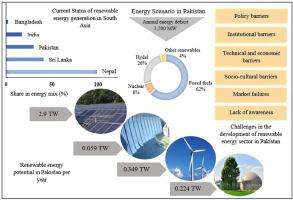Sustainable Energy Technologies and Assessments ( IF 8 ) Pub Date : 2020-04-17 , DOI: 10.1016/j.seta.2020.100707 Rizwan Rasheed , Asfra Rizwan , Hajra Javed , Abdullah Yasar , Amtul Bari Tabinda , Sumera Gull Bhatti , Yuehong Su

|
Relative sustainability of large-scale renewable energy technologies in South Asia has been assessed with special emphasis to Pakistan owing to the prevalent energy crises. South Asian countries are blessed with renewable energy resources that can effectively substitute the conventional resources. Pakistan is greatly dependent on fossils-based energy systems, spending 14.5 billion USD on fossil fuels’ import that is about 34% of its gross domestic product. It has been analysed that Pakistan is naturally blessed with annual hydropower potential of 0.06 TW, highest after India i.e. 0.15 TW and Nepal i.e. 0.083 TW in South Asia. Pakistan has the highest average solar insolation potential of 2.5 kWh/m2/day in the South Asia and can generate about 2.9 TW solar energy annually. Moreover, average wind speed of 7–9 ms−1 can yield 0.35 TW/year of wind energy. About 0.30 tons of biomass waste is being generated in the country annually, having a bioenergy potential of 166.72 TWh/year. India has the highest annual bioenergy potential of 2434.4 TWh followed by Bangladesh i.e. 373.6 TWh in South Asia. The conferred cross-country comparison will provide a factual roadmap to the decision-makers so to devise more focused approaches for addressing challenges associated with energy crisis in developing countries.



























 京公网安备 11010802027423号
京公网安备 11010802027423号